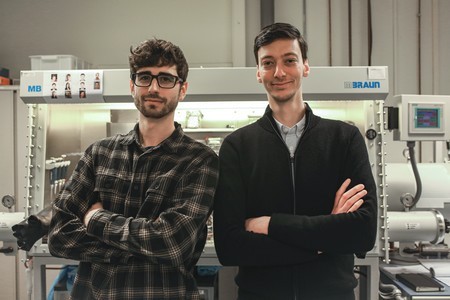Topprestatie van organische zonnecel gemaakt met tin oxide
Organische zonnecellen hebben een lichtgevoelige laag gemaakt van polymeren en kleine moleculen. Dit soort cellen is dun, flexibel en gemakkelijk te produceren, maar is minder efficiënt dan de gebruikelijk cellen van silicium. Natuurkundigen van de RUG hebben nu een organische zonnecel gemaakt met een efficiëntie van 17 procent, waarmee ze meedraaien in de top voor dit soort materialen. Een voordeel van de nieuwe zonnecel is dat deze is te maken is met technieken die gemakkelijk zijn op te schalen. Het ontwerp bevat een geleidende laag van tin oxide die met Atomic Layer Deposition is gemaakt. De onderzoekers hebben al verschillende ideeën om de efficiëntie en stabiliteit van deze zonnecellen te verbeteren. Hun resultaten zijn op 31 maart gepubliceerd in het tijdschrift Advanced Materials.
In organische zonnecellen zetten polymeren en kleine moleculen licht om in ladingen, die verzameld worden door elektroden. Dit soort cellen is gemaakt als een dunne film met verschillende laagjes – elk met andere eigenschappen – die op een substraat zijn gestapeld. De foto-actieve laag is de belangrijkste, die zet licht om in ladingen en scheidt deze in elektronen en de positieve ‘gaten’. Daarnaast is ook de transportlaag zeer belangrijk, die voert elektronen af naar de elektrode.

Voordelen
‘In de meeste organische zonnecellen is de transportlaag gemaakt van zink oxide, een transparant en geleidend materiaal dat onder de actieve laag ligt’, vertelt David Garcia Romero, promovendus in de onderzoeksgroep Fotofysica en Opto-elektronica van het Zernike Institute for Advanced Materials aan de RUG. Deze groep staat onder leiding van professor Maria Antonietta Loi. Garcia Romero en Lorenzo di Mario, een postdoc uit dezelfde groep, werkten het idee uit om tin oxide te gebruiken voor deze transportlaag. ‘Zink oxide reageert sterker op licht dan tin, dat daardoor zou moeten zorgen voor een stabielere cel’, legt Garcia Romero uit. Verder gebruikten ze een omgekeerde structuur, door de transportlaag bovenop de actieve laag te plaatsen.
Hoewel tin oxide in verschillende andere onderzoeken veelbelovend leek, was er nog geen goede manier gevonden om daarmee een transportlaag te maken in een organische zonnecel. ‘Wij gebruikten een techniek die Atomic Layer Deposition heet, en die al heel lang niet meer was toegepast bij dit soort zonnecellen’, vertelt Garcia Romero. En dat terwijl er toch flinke voordelen aan zitten: ‘Met deze methode kun je laagjes maken van uitstekende kwaliteit en de techniek is schaalbaar voor industrieel gebruik, bijvoorbeeld in rol-naar-rol productie.’

Geoptimaliseerd
De organische zonnecellen, met een via Atomic Layer Deposition aangebrachte laag tin oxide bovenop de actieve laag, bleken zeer goed te werken. ‘We haalden een topscore voor efficiëntie, met 17,26 procent’, vertelt Garcia Romero. De zogeheten fill factor, een belangrijke maat voor de kwaliteit van zonnecellen, had een waarde van zo’n 79 procent, ook een topwaarde voor dit soort materialen. Bovendien was het mogelijk om de optische en structurele eigenschappen van het tin oxide af te stellen door de temperatuur waarbij het materiaal is afgezet te wijzigen. De maximale omzetting van licht in energie werd bereikt in cellen waarin de tin oxide laag was afgezet bij 140 graden Celsius. Dit resultaat is behaald met twee verschillende actieve lagen, wat er op wijst dat het tin oxide de efficiëntie via een algemeen principe verbetert.
‘Ons doel was om organische zonnecellen op een efficiënte en schaalbare manier te maken’, aldus Garcia Romero. De efficiëntie die bereikt is ligt dicht tegen het maximum dat er nu staat voor organische zonnecellen, zo’n 19 procent. ‘En we hebben de overige lagen in het materiaal nog niet eens geoptimaliseerd. We moeten het nu dus nog een stap verder brengen.’ Hij wil ook graag, samen met zijn medeauteur Lorenzo di Mario, grotere cellen maken. Die werken minder efficiënt, maar zijn wel nodig in echte toepassingen, zoals zonnepanelen.

Inspireren
De nieuwe zonnecel met zijn imponerend hoge fill factor is een goed startpunt voor verdere ontwikkeling. Garcia Romero: ‘Het is nog wat vroeg om industriële partners te vragen dit te doen, wij moeten eerst zelf nog meer onderzoek uitvoeren. En we hopen dat ons gebruik van Atomic Layer Deposition andere in dit veld zal inspireren.’ Professor Loi vult aan: ‘We denken dat er nog veel te winnen valt in ons ontwerp. Maar het gebruik van tin oxide is een belangrijke eerste stap.’ Deze klasse van zonnecellen kunnen een belangrijke bijdrage leveren aan de energietransitie, vanwege hun mechanische eigenschappen en het feit dat ze grotendeels doorzichtig zijn. ‘We verwachten dat ze op een heel andere manier zullen worden gebruikt dan de silicium zonnepanelen’, zegt Loi. ‘We moeten echt buiten de gebaande paden denken over de toepassing.’
Referentie: Lorenzo Di Mario, David Garcia Romero, Han Wang, Eelco K. Tekelenburg, Sander Meems, Teodor Zaharia, Giuseppe Portale en Maria A. Loi: Outstanding Fill Factor in Inverted Organic Solar Cells with SnO2 by Atomic Layer Deposition. Advanced Materials, online 31 maart 2023.
Meer nieuws
-
11 december 2025
Stormachtige planeten en een onverwachtse atmosfeer
-
09 december 2025
RUG-hoogleraar bij COP30: ‘Het is altijd drama’
